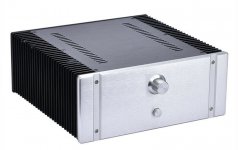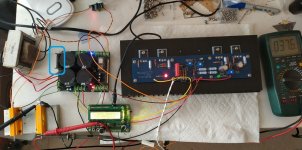In my 2A3 tube amp, I used the Mundorf MCap EVO (no oil) only for power supply bypass at the various stages.
For signal coupling, I liked WIMA MKP10 much more. 😀
In my Aleph J, I also have WIMA MKP10 for signal, or, I also like some MKC caps (either Zen Mod's blue Philips MKC, or ROE MKC1860) ...
If you have DC across the cap at all times (so "pre-loading" the cap), up to 10 uF or so, I often use just SILMIC II or Nichicon UES with no film bypass.
Regards, Claas
For signal coupling, I liked WIMA MKP10 much more. 😀
In my Aleph J, I also have WIMA MKP10 for signal, or, I also like some MKC caps (either Zen Mod's blue Philips MKC, or ROE MKC1860) ...
If you have DC across the cap at all times (so "pre-loading" the cap), up to 10 uF or so, I often use just SILMIC II or Nichicon UES with no film bypass.
Regards, Claas
Extreme_Boky and peppennino, thanks for responding to my post. I decided to go with the 5U chassis. My plan is to build the Aleph J in that. Once I have the time to learn/practice drilling and tapping metal, I’ll move it into a 400mm deep 4U chassis and use the 5U for a future BA build. I ordered all of the parts yesterday, so should start building in a week or two. Thanks again for your help. Very excited to get going on this.
I have almost zero metal working skills, but I don't find drilling and tapping heatsink holes too hard, especially with access to a drill press.
The main things are to use cutting fluid, go slowly and back out and clear the tap before anything bad happens. 🙂
Have fun!
The main things are to use cutting fluid, go slowly and back out and clear the tap before anything bad happens. 🙂
Have fun!
>> The main things are to use cutting fluid
Can't stress that enough! Cutting fluid made all the difference for me.
I just finished drilling diyAudio's Universal Mounting Spec 28 holes on my heat sinks using 3mm tap and 2.5mm drill (drill press for drilling and hand tapping). For some reason, Irwin #4-40 tap+drill bit pair was easier. Drill America taps (from amazon) works really well and that is my new favorite.
Can't stress that enough! Cutting fluid made all the difference for me.
I just finished drilling diyAudio's Universal Mounting Spec 28 holes on my heat sinks using 3mm tap and 2.5mm drill (drill press for drilling and hand tapping). For some reason, Irwin #4-40 tap+drill bit pair was easier. Drill America taps (from amazon) works really well and that is my new favorite.
 .... and "cutting fluid" for aluminium can be denatured alcohol for both tapping and drilling - in case anyone is in doubt (or non denatured in case you drink and drill - not recommended).
.... and "cutting fluid" for aluminium can be denatured alcohol for both tapping and drilling - in case anyone is in doubt (or non denatured in case you drink and drill - not recommended). (Regards a skilled fitter a long time ago 😉)
Last edited:
Some progress on my Aleph J build
I just tested two individual channels of my Aleph J using a +/-12V transformer and both boards are working fine!
During testing, the bridge rectifier which is on a small heatsink, got pretty hot to touch. I am using the following part. Do I need to go for anything bigger?
GSIB1560-E3/45 Vishay General Semiconductor | Mouser
For now, I am going to assemble this in a smaller chassis, so I am thinking of using 2x16V toroidal transformer on each side.
Chassis size:
External: 320x130x313 mm
Internal: 220x122x300 mm
Heatsinks: 300x50x130 mm (approx 3U x 300mm)
I just tested two individual channels of my Aleph J using a +/-12V transformer and both boards are working fine!
During testing, the bridge rectifier which is on a small heatsink, got pretty hot to touch. I am using the following part. Do I need to go for anything bigger?
GSIB1560-E3/45 Vishay General Semiconductor | Mouser
For now, I am going to assemble this in a smaller chassis, so I am thinking of using 2x16V toroidal transformer on each side.
Chassis size:
External: 320x130x313 mm
Internal: 220x122x300 mm
Heatsinks: 300x50x130 mm (approx 3U x 300mm)
Attachments
The bridge I am using is 15A for one side, so I will try to fit a larger heatsink and see if that helps. It is a PITA to remove components from these PTH PCBs.
How to calculate the maximum obtainable output power for a given Iq?
If the total Iq for one channel is set at 1.2A (0.6A for each transistor) with +/-20V rails, what would be the maximum output power of the amplifier into 8 Ohm?
If the total Iq for one channel is set at 1.2A (0.6A for each transistor) with +/-20V rails, what would be the maximum output power of the amplifier into 8 Ohm?
Bypass capacitors C6/C7 were out of stock when I ordered the BOM:
MKP2D031001F00JSSD WIMA | Mouser
Would these work for those two bypass capacitors?
FG26X7R1H474KNT06 TDK | Mouser
I am under the impression that MLCC's are good for bypass
MKP2D031001F00JSSD WIMA | Mouser
Would these work for those two bypass capacitors?
FG26X7R1H474KNT06 TDK | Mouser
I am under the impression that MLCC's are good for bypass
I'd go with WIMA polypropylene dielectric, which has the lowest distortions for audio coupling duties. You do not necessarily need to use 0.1uF. Consider 0.47 or 0.68 or even 1uF will do nicely as well.
I'd avoid the Multilayer Ceramic dielectric at all costs - in audio signals coupling applications.
I'd avoid the Multilayer Ceramic dielectric at all costs - in audio signals coupling applications.
The bypass are not necessary... the factory wired Aleph amplifiers didn't have them.
Use whichever you like, or not, the amp will work properly and sound fantastic either way.
Use whichever you like, or not, the amp will work properly and sound fantastic either way.

I am now playing some songs through my Aleph J and it is certainly one of the best! Audacious running on a Raspberry PI with onboard i2s DAC is the source. First thing I noticed was rock solid imaging!
Still need to clean up some wiring, and also find better heat sinks for the bridge rectifiers before I can close the lid!
Very happy with the build and how it turned out!
Still need to clean up some wiring, and also find better heat sinks for the bridge rectifiers before I can close the lid!
Very happy with the build and how it turned out!
- Home
- Amplifiers
- Pass Labs
- Aleph J illustrated build guide

